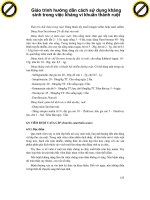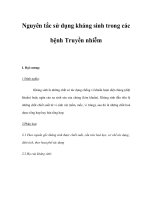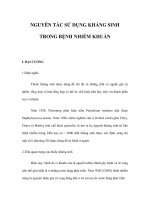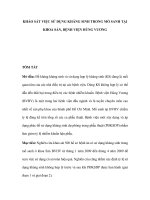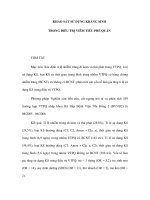Bài giảng cách sử dụng kháng sinh trong nhi khoa
Bạn đang xem bản rút gọn của tài liệu. Xem và tải ngay bản đầy đủ của tài liệu tại đây (1.63 MB, 38 trang )
PGS.TS Phaạm Nhâạt An
Nh ắc l ại đượ c các ki ến th ức c ơ b ản v ề KS v à
các nhóm kháng sinh, nguyên t ắc c ơ b ản “s ử
d ụng KS h ợp lý”
N ắm v ững ch ỉ đị nh v à nguyên t ắc l ựa ch ọn
KS cho tr ẻ em, các cách tính li ều l ượ ng
thu ốc, đườ ng dùng… các tai bi ến, tác d ụng
ph ụ c ủa KS cho TE
C ập nh ật v ấn đề áp d ụng kháng sinh đi ều tr ị
nh ững b ệnh nhi ễm trùng hay g ặp trong Nhi
khoa
Mộạt sộố khái niệạm
Điều trị:
-
-
Dùng thuốc
Không dùng thuốc
Kết hợp
Điều trị toàn diện (Comprehensive
Treatment)
Quản lý thuốc điều trị(Medication therapy
management)
Nhữữn g chú ý khi dùng thuộốc
cho trẻẻ ẻm
Chỉ định đúng, liều lượng đúng…
Chọn loại thuốc, dạng bào chế thích hợp
Đường dùng thích hợp
TM? Bắp? Uống? Sonde dạ dày? Dưới da?
Đường HM? Bôi? Tra? Khí dung?....
Kỹ thuật áp dụng:
- Dùng lúc no? Đói? Sốt? Tiêu chảy?
- TS Dị ứng?...
Kháng sinh là những chất do vi sinh vật tiết ra hoặc những
hoạt chất hóa học bán tổng hợp, tổng hợp có khả năng đặc
hiệu kìm hãm sự phát triển hoặc tiêu diệt được các vi sinh vật
khác với nồng độ rất thấp
“ A drug used to treat infections caused by
bacteria and other microorganisms.
Originally, an antibiotic was a substance
produced by one microorganism that
selectively inhibits the growth of another.
Synthetic antibiotics, usually chemically
related to natural antibiotics, have since been
produced that accomplish comparable tasks. "
Antibacterial
Antifungal
Antimycobacterial
Antiparasitic
Antiviral
Biological Hep B-Hyperimmune globulin
Intravenous immune globulin Palivizumab
Rabies- Hyper immune globulin
Tetanus- Hyperimmune globulin
VIG (Vaccinia Immune Globulin)
Varicella Zoster- Hyperimmune globulin
rho (D) immune globulin
Other
Lindane Treatment of Sarcoptes scabiei ( scabies)
Malathion Pediculus capitis = viêm nang (tóc, da…)
Permethrin (Sarcoptes scabiei var hominis )
-
Đặc đi ểm phân t ử c ơ b ản l à có vòng
Beta-lactam ho ạt hoá
Tác độ ng lên th ành t ế b ào
Bao g ồm:
Penicillins
Cephaloprins ( 4 th ế h ệ)
Carbapenems: Imipenem, Meropenem…
Chú ý: L à nhóm KS ch ủ ch ốt, nhi ều lo ại
có ph ổ r ộng, đượ c dùng khá r ộng rãi nh ưng c ần chú tr ọng t ới ph ản ứng s ốc
ph ản v ệ
1 generation:
PO: Cephalexin, cephadroxil, cephradin…
IM, IV: Cefazolin, cephalotin, cephapirin…
2 generation:
- Cefamandole IV/IM Cefuroxime IV/IM;
CefoxitinIV/IM; CefotetanIV/IM Cefmetazole IV
- Cefaclor PO; Cefprozil250-500mg PO; Cefpodoxime
PO; Loracarbef PO
3 generation:
- Cefotaxime1-2gmIV/IM; Ceftriaxone IV/IM;
Ceftizoxime IV/IM; Ceftazidime IV/IM;
CefoperazoneIV/IM;
- Cefixime PO
4 generation:Cefipime
Generally distributes well into the lung; kidney;
urine; synovial, pleural, and pericardial fluids.
Penetration into the cerebral spinal fluid (CSF) of
some 3rd generation cephalosporins (cefotaxime,
ceftriaxone, and ceftazidime) is adequate to
effectively treat bacterial meningitis.
Elimination is primarily via the kidneys
Few exceptions include cefoperazone and
ceftriaxone which have significant biliary
elimination.
The earlier generation cephalosporins are
commonly used for community-acquired
infections
The later generation agents , with their better
spectrum of activity against gram-negative
bacteria make them useful for hospitalacquired infections or complicated
community-acquired infections.
Hypersensitivity reactions
manifested by rashes, eosinophilia, fever (13%); interstitial nephritis.
1-7% of patients with penicillin allergies will
also be hypersensitive to cephalosporins .
Cephalosporins should be avoided in patients
with immediate allergic reactions to
penicillins (eg: anaphylaxis, bronchospasm,
hypotension, etc.).
Cephalosporins may be tried with caution in
patients with delayed or mild reactions to
penicillin.
Thrombophlebitis (1-5%).
Group 1 includes broad-spectrum Carbapenems,
with limited activity against non-fermentative
Gram-negative bacilli, particularly suitable for
community acquired infections (e.g. ertapenem).
Group 2 includes broad-spectrum Carbapenems,
with activity against non-fermentative Gramnegative bacilli that are particularly suitable for
nosocomial infections (e.g. imipenem and
meropenem).
Group 3 includes Carbapenems with clinical activity
methicillin-resistant Staphylococcus aureus
Amongst these the most widely used Carbapenems
include: Meropenum ,Imipenum +Cilastin
Appropriate use
Empiric treament of severe nosocomial
infections in critically ill patients or in ICU
Failure of first-line antibiotics for Gramnegative bacterial (GNB) infections
Directed treatment according to results of
culture and susceptibility testing
Chronic multiresistant pseudomonal
infections
In certain settings of neutropenic sepsis,
severe nosocomial intra-abdominal sepsis
and meningitis
Inappropriate use
Routine treatment of otitis media
Routine treatment of acute exacerbations of
chronic bronchitis
Surgical prophylaxis
Routine treatment of community-acquired
pneumonia (CAP)
Routine treatment of community-acquired
gynaecological infections
Routine treatment of community-acquired
urological infections
Nosocomial or communityacquired Grampositive sepsis
L à nhóm KS tác độ ng lên s ự t ổng h ợp Protein
c ủa VK
Tác d ụng ch ủ y ếu lên các tr ực khu ẩn Gr(-)
Ít khi dùng đơn độc; th ường ph ối h ợp v ới
nhóm Beta-Lactam nh ư Penicillin v à
Ampicillin, các thu ốc kháng lao…
C ần chú ý t ới độ c tính lên thính giác v à th ận
C ơ ch ế tác d ụng : Ưc ch ế t ổng h ợp Protein
c ủa VK
Bao g ồm:
- Streptomycin
- Gentamycin
- Kanamycin
- Amykacin
- Neomycin
- Neltimycin
- Tobramycin
- Spectinomycin
- Flamycetin
Erythromycin: Th ườ ng dùng ĐT NT do
Campylobacter, Mycoplasma
pneumonia, ho g à, clamydia…
Clarithromycin: Tác d ụng t ốt h ơn, h ấp
thu qua đườ ng tiêu hoá t ốt h ơn Ery.
Ngo ài ra còn có tác d ụng t ốt v ới
Mycobacterium Avium, H. pylori, H.
Influenza.
Azithromycin: Đặ c bi ệt tác d ụng t ốt
h ơn v ới H. Influenza, có th ể dùng 1
l ần/ ng ày v ới li ều ng ắn ng ày
Roxithromycin: T ương t ự Azithromycin
C ơ ch ế tác d ụng: Ưc ch ế t ổng h ợp Protein c ủa
VK
Tác d ụng v ới VK Gr(-), VK y ếm khí
H ấp thu t ốt theo đườ ng tiêu hóa
Ng ấm t ốt v ào m àng não
Chú ý độ c tính v ới t ủy x ươ ng
C ơ ch ế TD: Ưc ch ế t ổng h ợp Protein c ủa VK.
Tác d ụng t ốt lên các lo ại c ầu khu ẩn,
Ricketsia, Mycoplasma, Spirochaetes
(Treponema Pallidum), Chlamydia…
Độc v ới gan, th ận, men r ăng tr ẻ nh o <8 t.
Các s ản ph ẩm chính:
Tetracycline
Doxycycline
Minocycline
C ơ ch ế TD: Tác độ ng lên vách VK
TD t ốt v ới các VK Gr(+), đặ c bi ệt c ầu khu ẩn
kháng Methicillin (Oxa. Cloxacillin)
Độc v ới th ận, d ị ứng da…
S ản ph ẩm chính:
Vancomycin
Teicoplanin
C ơ ch ế TD: Ưc ch ế SX DNA v à c ả RNA (gián
ti ếp t ới t ổng h ợp Protein c ủa VK)
Tác d ụng t ốt v ới nhi ều lo ại VK – k ể c ả VK y ếm
khí – tr ư TT m ủ xanh
Có 4 th ế h ệ Quinolones, nh ững th ế h ệ sau ph ổ
kháng khu ẩn r ộng h ơn.
Clindamycin
Cotrimoxazole (Trimethoprim +
Sulphamethoxazole)
Methronidazole
Nitrofurantoin
Rifampicine
Fosfomycin
Fusidic Acid
Ph ải có b ăng ch ứng c ủa nhi ễm khu ẩn:
Bi ểu hi ện lâm s àng :
S ốt, các d ấu hi ệu nhi ễm khu ẩn to àn thân…
Các d ấu hi ệu khu trú t ại c ơ quan b ị nhi ễm
khu ẩn
D ịch t ễ
Các XN:
Công th ức b ạch c ầu
PCR
Soi, c ấy b ệnh ph ẩm tìm VK
L ấy XN vi sinh tr ướ c khi s ử d ụng KS
Theo lo ại Vi khu ẩn v à Kháng sinh
đồ
Theo b ệnh, theo c ơ quan b ị nhi ễm
khu ẩn , theo tình tr ạng n ặng c ủa
nhi ễm khu ẩn
Theo các k ết qu ả nghiên c ứu
( MetaAnalisis )
Theo kinh nghi ệm (expertise)




